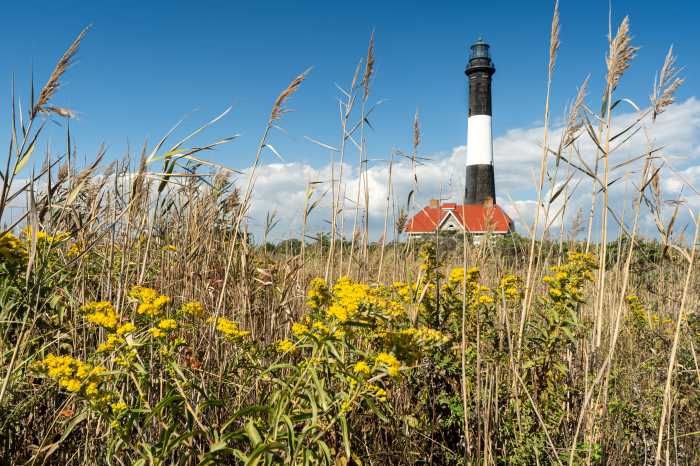The long-awaited $1.7 billion federally funded Fire Island to Montauk Point (FIMP) coastal flooding mitigation project officially got underway this off-season – more than a half century after it was first proposed.

MAJ. GEN. WILLIAM H. GRAHAM SPEAKS AT THE FIRE ISLAND LIGHTHOUSE ON DEC. 17, 2021.
The first of the 11 contracts within FIMP entailed dredging 1.4 million cubic yards of sand from Fire Island Inlet and pumping it onto Gilgo Beach State Park and Robert Moses State Park, where the sand was spread across about 10,000 linear feet of beach in each location. The other FI-specific work planned involves ripping out the two jetties in Ocean Beach and moving the village’s public drinking water well back from its current oceanfront location. Dredging the Moriches Inlet will follow as the work will later head eastward to the South Fork. Overall, phase one is beach replenishment and phase two involves raising more than 4,400 structures in flood-prone areas across 83 miles of the South Shore.
“We never thought this was possible, we never thought we would get to this day,” said Maj. Gen. William H. Graham, the deputy commanding general for Civil and Emergency Operations for Army Corps projects nationwide – one of the top four commanders of the agency – who was the highest-ranking official on hand for the December news conference at the Fire Island Lighthouse. He credited the project’s start to local officials and advocates “who for decades have been working diligently to understand the challenges that that sometimes angry sea poses to everybody who lives out here.”
While FIMP had been debated for longer than many of its beneficiaries have been alive, funding wasn’t secured until Congress approved a $50 billion package in 2013 to aid in the recovery from Superstorm Sandy, which washed away a dozen homes and breached Fire Island 10 years ago this October.
Some contracts that were going to be part of FIMP were spun off from the main project and completed as part of the Fire Island Inlet to Moriches Inlet (FIMI) work, which used seven million cubic yards of sand to replenish beaches, rebuild dunes and related efforts across the barrier island from 2014 through 2019.
The work comes as scientific consensus shows climate change-driven sea level rise is projected to cause increased beach erosion and leave parts of coastal communities underwater while warmer ocean temperatures continue fueling more frequent strong, damaging storms.
“With the threats of extreme weather becoming more and more common, we simply cannot leave our coastlines vulnerable,” said Suffolk County Executive Steve Bellone, who suggested the intergovernmental cooperation required to execute FIMP was nothing short of miraculous. “Superstorm Sandy showed us just how important planning for the future is, and the FIMP project will not only help strengthen miles of our shoreline and reduce storm damage but will help make coastal communities along our South Shore, which are vital to the local economy, more resilient.”
New York State Department of Environmental Conservation Commissioner Basil Seggos, who was also on FI for the announcement, alluded to how plans to build offshore wind farms in the Atlantic also aims to help stop the climate trend from worsening.
“Year after year, our changing climate is driving an uptick in flooding and severe storms,” he said. “To protect our communities and our natural resources, we must work together to increase resiliency, reduce climate-altering greenhouse gas emissions, and ramp up renewable energy sources.”
Houston-based Great Lakes Dredge and Dock Company won the first contract to pump sand from the inlet onto the beaches with berms and man-made dunes added. The contract also includes the construction of coastal process features in Robert Moses State Park that are designed to enhance federally protected piping plover habitats.
Once FIMP reaches the East End in the coming years, plans include construction of what’s known as a feeder beach – an artificially widened beach that nourishes down-drift beaches – in Montauk. That’s because littoral drift on Long Island’s ocean beaches causes sand to naturally flow from east to west.
After it’s done, FIMP calls for beach renourishment about every four years for up to 30 years following the project’s completion, although the state and local governments will have to split the cost of future maintenance.
Not everyone cheered FIMP’s kickoff. Among its critics is Steven Resler, a retired state Department of State coastal manager who urges the state to enforce a 1981 law mandating strategic retreat and selective fortification – not rebuilding beach homes lost to storms, but constructing a sea wall for lower Manhattan, for example.
“If New York had been properly implementing its programmatic and statutory obligations over the past four decades, many of our greatest problems along the coast would have been phased out, eliminated, and prevented by now,” he said. “New York is failing its coast. Our coast. Our future. And our children’s children’s children’s futures.”



























